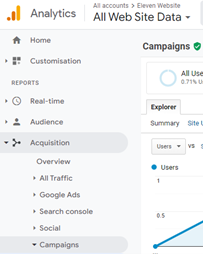How UTM codes work
UTM stands for Urchin Tracking Module – although we’ll be surprised if you ever come across the term in full. Usually known more simply as UTM codes or UTM tags, they take the form of snippets of text which are added to the end of a URL to help you track where your website traffic is coming from.
You might be asking yourself “but what does a UTM code tell me that I can’t already tell from Google Analytics or HubSpot?” Well, say you’re promoting a campaign on social media. While Google Analytics will tell you how much traffic came from social media, a UTM will actually tell you how much of that traffic came to your website from a specific Facebook post.
It’s important to note that UTM codes won’t have any affect on the performance of the page you’re linking to. It’s simply there to send signals to your analytics programme about who’s arriving on your site from where.
How to build UTM codes for your campaign
When building and using UTM codes, here is a quick checklist to follow:
- Connect UTM tracking to your CRM
- Make sure your URLs are clean and simple
- Define your UTM parameters so you know what you’re tracking and where
- UTM codes are case sensitive, so stick to just one case
There are many different ways you can build UTM codes. Our preferred way is through the Google Analytics Campaign URL builder. This tool allows you to really easily add UTM codes to URLs so you can measure your campaigns more effectively. The tool is really easy to use and can be accessed here.
Tracking codes can be added to digital marketing assets such as an email or social media post. But they can also be used on printed assets like posters or leaflets through QR codes – which have soared in popularity since Track and Trace! Check out this fantastic example from Paramount+, who deployed 400 drones to create a giant scannable QR code in the sky to promote their new ‘Halo’ series.

How to measure your success
Once you’ve got your custom URL, you’ll be able to use it in your marketing campaign – whether that’s in a social post or within a marketing email. If you’ve already got Google Analytics set up for your website, your results will automatically start tracking and you’ll be able to measure your performance as you go along. To do this, login to your Google Analytics account and you can access ‘campaigns’ in the ‘Acquisition’ drop down in the main menu.
 UTM codes help you to measure the success of your campaign by enabling you to make more informed decisions going forward as you look at which activity performed best. This kind of insight can help you shape your future campaign activity, accordingly, meaning you can get the most out of your available marketing budget.
UTM codes help you to measure the success of your campaign by enabling you to make more informed decisions going forward as you look at which activity performed best. This kind of insight can help you shape your future campaign activity, accordingly, meaning you can get the most out of your available marketing budget.
With UTM codes, you can look at your data in a whole new, detailed light. With the help of the above guidance and tools, you’ll be able to start creating UTM codes that will enable you to track the performance of your marketing campaigns and content.
Looking for support getting started with UTM codes? Get in touch and we’ll be more than happy to help.
Originally published:
June 30, 2022
Updated:
December 20, 2023





